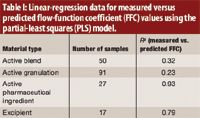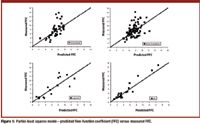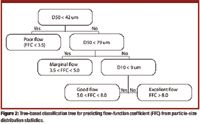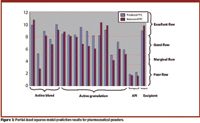Modeling Pharmaceutical Powder-Flow Performance Using Particle-Size Distribution Data
The authors present a simple and material-sparing approach for estimating the powder-flow performance of previously uncharacterized single-component bulk powders when only particle-size distribution data are available.
Pharmaceutical powders can be very different in their particle chemistry, morphology, and size, which can significantly affect their bulk-flow properties. Free-flowing powders are desirable to enable robust powder processing operations such as bin filling, hopper discharge, and capsule and die filling. It is well established that particle size (mean and distribution) is one of the most significant factors that affects the flow behavior of powders (1, 2). Small particles (<20 μm) have a relatively high surface area to volume ratio, causing interparticulate attractive forces to dominate and resist bulk flow when a shear stress is applied. Larger particles (>100 μm) tend to roll or slide over one another when a shear stress is present and, thus, exhibit superior bulk flow properties compared with small particles. This is because gravity forces significantly exceed interparticle forces such as those caused by electrostatic or van der Waals interactions for particles in this size range. In addition, a broad particle-size distribution (PSD) with both large and small particles enables more efficient particle packing, which leads to an interlocking effect as the small particles fill in the gaps between the contact surfaces of larger particles. The absolute size and distribution of particles in a powder sample, therefore, collectively contribute to the sample's bulk powder-flow behavior.
The quantification of powder-flow properties with a small quantity of material (<20 g) is essential for material sparing and cost-saving predictive assessments. Amidon and Houghton remark that useful powder-flow evaluation tools should be reproducible, sensitive, yield meaningful results, and require small amounts of material (3). Because only small (expensive) quantities of powder are available during early dosage-form design and because the synthetic process may not be finalized, having a simple material-sparing screening tool that can rapidly evaluate the powder flow of these samples is attractive (3). Even with small-scale tools such as shear cells for the evaluation of powder-flow performance, however, it is desirable to predict powder-flow performance using less than 1 g material during prototype active pharmaceutical ingredient (API) or drug-product design.
Particle-size analysis tools such as laser diffraction can measure the PSD of less than 1 g of material. It is beneficial to prototype API and solid-dosage formulation design if the flow performance of powders can be predicted using particle-size data. This method offers a significant advantage to a material-sparing approach because bulk property measurements such as flow cannot be scaled down much below a few grams due to the fact that they are dominated by interparticle interactions.
The authors hypothesize that the relative powder-flow performance of a bulk powder sample is influenced by and can be predicted from its PSD. The objective of this investigation is to develop a quantitative empirical model for predicting an established single flow-performance parameter, the flow-function coefficient (FFC), from input PSD statistics. This model may then be used to predict the flow behavior of new powdered pharmaceutical materials.
Materials
A proprietary database containing PSD and powder-flow data was queried for all powders containing PSD and FFC data. The query produced a representative sample of 185 pharmaceutical powders tested during a three-year period (see Table I). The volume mean diameter (VMD, D[4,3]) and FFC values ranged from 2 to 457 μm and 1.2 to 28.5, respectively. These are typical ranges for powdered bulk materials (4).

Table I: Linear-regression data for measured versus predicted flow-function coefficient (FFC) values using the partial-least squares (PLS) model.
Methods
Particle-size analysis. The PSD of each sample was evaluated using a Sympatec Helos/Rodos laser diffraction particle-size analyzer (Sympatec Inc., Lawrenceville, NJ) with dry dispersion capability. Small bulk samples (0.5–5.0 g) were introduced to the dry dispersion feeder system using a vibratory feed tray. The dispersion pressure was optimized (0.5–4.0 bar) to reasonably break up any loose agglomerates in the sample. The laser diffraction system, equipped with the appropriate lens for the sample's particle-size range was used to measure the PSD of the sample in 31 channels. The cumulative PSD and common PSD statistics (D10, D50, D90, D[4,3]) were calculated using the Sympatec Windox 4.0 software.
Powder flow testing. The powder-flow behavior of each sample was determined using a Schulze ring shear tester model RST-XS [Dietmar Schulze, Wolfenbuttel, Germany]. In general, the RST-XS medium-sized annular cell (31.37 cm3) was used to conduct each yield locus test because it is suitable for most pharmaceutical testing where bulk quantities are often limited. Where appropriate, the large-sized cell was used for powders with particles larger than 500 μm. Each sample was equilibrated in a closed environment at 20 ± 2 °C and 50 ± 2% relative humidity for 16–24 h before testing to minimize the effects of moisture uptake. Although the influence of humidity on powder-flow properties or PSD were not explicitly explored in this work, the adhesion force between contacting particles is known to often increase with absorbed water, thus inhibiting flow performance (5).
The equilibrated powder was spooned into the test cell and carefully leveled with the top of the annulus to form an unconsolidated powder bed with minimal voids. The cell was placed on the driving axle of the tester and fitted with the lid to which the shear force tie rods and normal loading rod were connected. The steady-state shear stress of each powder was measured as the powder was subjected to a series of applied normal loads ranging from 1 to 2.6 kPa. Before each load, the powder was sheared to a steady state at 4 kPa, which helped create a consistent initial powder bed condition (i.e., bulk density). From the yield locus plot, the ratio of the principle consolidation stress (σ1) to the unconfined yield strength (FC) was used to calculate the FFC value.
Data modeling. The laser-diffraction analysis provided 31 channels of PSD for each powder, which allowed detailed PSD to be constructed. The 10th, 50th, and 90th percentiles of the distribution were calculated for each material. In addition, the VMD (D[4,3]) calculated by the Sympatec Windox software was used as an input for the models. These four parameters were selected because they are commonly used PSD statistics. The response variable, FFC, was subdivided into four categories related to the powder's relative flow performance based on the laboratory's experience with powders (see Table II).

Table II: Rating categories for flow-function coefficient (FFC) values.
Two statistical methods were applied for correlating the PSD and FFC values: partial least squares (PLS) and tree-based regression. The PLS method generates a linear model describing the FFC in terms of the PSD values. The output is a linear model containing weighted linear combinations of PSD percentiles, which is used to calculate the FFC value. Preliminary statistical analysis of the data suggested a logarithmic relationship between the FFC and PSD values. This is not surprising because many properties of bulk powder and compacts are related via logarithmic relationships (e.g., compact tensile strength and solid fraction) (1). This is consistent with other research demonstrating empirical relationships between powder-flow parameters such as flow function or angle of internal friction and a single particle-size parameter. Kohler and Schubert report a model for describing a relationship between the inverse flow function (1/FF) and the median particle-size diameter (D50) for fine alumina powders (5). Podczeck and Miah found that the angle of internal friction of unlubricated powders is dependent on particle size and shape (6).
A tree-based model (7) was also used to generate splitting criteria for the powder-flow performance category based on one or more of the PSD statistics (e.g., if distribution statistic X is < Y μm, then powder flow is classified as poor). Tree-based modeling is often used in data mining investigations such as this where the most important inputs for describing a response must be identified.
In each method, four common measurements provided in particle-size analysis (D10, D50, D90, D[4,3]) were used to build the models. Initial results showed that there was no significant advantage to using additional PSD statistics to parameterize the model. The four-parameter model, therefore, was pursued; these distribution statistics are typically readily available as outputs from particle-size analysis.
Results
PLS modeling. PLS regression analysis method was used to develop a model to predict the FFC value from the PSD statistics for each material type. A single model to describe all material types could not predict the FFC value as well as a model built for a single material type. Therefore, separate models were built for active blends, active granulations, excipients, and APIs. This is not surprising considering the shape of the PSD curves and their response to shear stresses can be quite different across material types; for example, single component systems are typically uni-modal, but granulations are typically polymodal.
The authors developed a four-parameter model using the most commonly reported PSD statistics for each material type to predict the FFC value from the PSD statistics, as shown below.
FFC = exp(b0 + b1 ln D10 + b2 ln D50 + b3 ln D90 + b4 ln D[4,3])
A plot of the measured versus predicted FFC value for each material type is shown in Figure 1. Visual inspection of these plots suggests that the predictions for the API and excipient FFC values are superior to the active blends and active granulations. The R2 values in Table I describe the quality of the fit of linear regressions through the data in Figure 1 and, therefore, confirm this observation. The R2 values for the API and excipient models were 0.93 and 0.79, respectively, suggesting good model fits. The R2 values for the active blends and active granulations were all <0.32, suggesting that the models were not able to describe the flow performance of these materials using particle-size data with the same level of confidence. These results suggests that PSD statistics alone in the PLS models are more appropriate for predicting the flow performance of single component APIs or excipients. The models, however, may be useful for investigating potential differences in flow performance for like-composition formulations that have been subjected to different manufacturing process conditions.

Figure 1 (FIGURES ARE COURTESY OF THE AUTHORS.)
Tree-based classification model. A tree-based classification approach was used to categorize flow performance of the powders based on the relevant PSD statistics. The literature has reported similar rules of thumb for estimating flow behavior from particle size. For example, Staniforth reports that particles larger than 250 μm are usually free flowing; particles smaller than 100 μm become cohesive; and particles less than 10 μm are extremely cohesive (2). This statistical method selects the particle size parameters that are most significant in describing or categorizing the flow performance. The tree-based model was generated from the data using four parameters of the PSD: D10, D50, D90, and D[4,3].
The classification tree results in Figure 2 show that, for both models, only two distribution statistics were significant when predicting the flow category: the D10 and 50. These results further support the hypothesis formed in the PLS discussion that models that use PSD statistics to predict powder flow do not require (or cannot be any better predicted by) a multitude of parameters. These models are probably the most useful for forming "rules of thumb" when using PSD data to predict powder-flow performance. When higher resolution flow characterization is required, the PLS model described above or measuring the flow performance of the powder is preferred.

Figure 2
Testing the models. To investigate the predictive power of the PLS model, the authors evaluated the PSD and powder-flow performance of additional powder samples to test the predictions. Data from these materials were not used for the development of these models. In most cases, the models predicted the FFC value within the same flow category (excellent, good, marginal, poor) as the measured value (see Figure 3). Case 2 was an exception. In this case, the active blend contained an unusually high proportion of fines (D10=4 μm) because of a 25% loading of an API with a median diameter of 10 μm. Even with this discrepancy, however, a simplified set of PSD statistics (i.e., D10, D50, D90, D[4,3]) was found to suitably predict an estimated FFC on average to plus or minus one FFC unit for these newly characterized materials.

Figure 3
Conclusion
Models have been developed for predicting relative powder-flow performance using PSD data. The PLS model, which used D10, D50, D90, and D[4,3] as input parameters, is suitable for predicting the FFC value for APIs and excipients and may also be appropriate for predicting PSD influences on other materials (e.g., active blends and active granulations). This empirical tool leverages a material and resource-sparing approach to the powder-flow performance characterization. In addition, the tool can be particularly useful during prototype drug-product design, especially with regard to risk assessments when little is known about the flow performance of a new API or excipient.
Acknowledgment
The authors would like to thank Bruno Hancock for reviewing this work and providing technical guidance.
Matthew P. Mullarney* and Norma Leyva are senior scientists at Pfizer, Inc., Eastern Point Rd., Groton, CT 06340, tel. 860.715.4139, matthew.p.mullarney@pfizer.com.
*To whom all correspondence should be addressed.
Submitted: June 16, 2008. Accepted: July 8, 2008.
What would you do differently? Submit your comments about this paper in the space below.

References
1. E.N. Hiestand, "Mechanics and Physical Principles for Powders and Compacts" (SSCI Inc., West Lafayette, IN, 2002), p 110.
2. J. Staniforth, "Powder Flow," in Pharmaceutics: The Science of Dosage Form Design, M.E. Aulton, Ed. (Churchill Livingstone, Edinburgh, UK, 2002) pp. 197–210.
3. G.E. Amidon and M.E. Houghton, "Powder Flow Testing in Preformulation and Formulation Development," Pharma. Manuf., 2 (7) 21–31 (1985).
4. A.W. Jenike, "Storage and Flow of Solids," in Utah Engineering Experiment Station Bulletin 123, 16th ed., (University of Utah, Salt Lake City, UT, 1964).
5. T. Kohler and H. Schubert, "Influence of Particle Size Distribution on the Flow Behavior of Fine Powders," Part. Syst. Charact. 8 (1–4), 101–104 (1991).
6. F. Podczeck and Y. Miah, "The Influence of Particle Size and Shape on the Angle of Internal Friction and the Flow Factor of Unlubricated and Lubricated Powders," Int. J. Pharm. 144 (2) 187–194 (1996).
7. L. Breiman et al., "Classification and Regression Trees" (Chapman & Hall/CRC, Boca Raton, FL, 1984).

Drug Solutions Podcast: A Closer Look at mRNA in Oncology and Vaccines
April 30th 2024In this episode fo the Drug Solutions Podcast, etherna’s vice-president of Technology and Innovation, Stefaan De Koker, discusses the merits and challenges of using mRNA as the foundation for therapeutics in oncology as well as for vaccines.